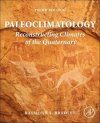![Paleoclimatology: Reconstructing Climates of the Quaternary Paleoclimatology: Reconstructing Climates of the Quaternary]()
Click to have a closer look
About this book
Contents
Customer reviews
Biography
Related titles
About this book
Paleoclimatology: Reconstructing Climates of the Quaternary, Third Edition, provides a thorough overview of the methods of paleoclimatic reconstruction and of the historical changes in climate during the past three million years.
This thoroughly updated and revised edition systematically examines each type of proxy and elucidates the major attributes and the limitations of each. Paleoclimatology, Third Edition provides necessary context for those interested in understanding climate changes at present and how current trends in climate compare with changes that have occurred in the past. The text is richly illustrated and includes an extensive bibliography for further research.
Contents
Contents
Preface
Acknowledgements
Chapter 1 Paleoclimatic reconstruction
Chapter 2 Climate and climatic variation
Chapter 3 Dating methods I
Chapter 4 Dating methods II
Chapter 5 Ice cores
Chapter 6 Marine sediments
Chapter 7 Loess
Chapter 8 Speleothems
Chapter 9 Lake sediments
Chapter 10 Non-marine geological evidence
Chapter 11 Insects and other biological evidence from continental regions
Chapter 12 Pollen
Chapter 13 Tree rings
Chapter 14 Corals
Chapter 15 Historical documents
Appendix 1: Further considerations on radiocarbon dating
Appendix 2: Internet resources in paleoclimatology
References
Customer Reviews
Biography
Raymond S. Bradley has been involved in many national and international activities related to paleoclimatology, most notably as the current Chair of the Scientific Steering Committee for the International Geosphere-Biosphere Program on Past Global Changes (IGBP-PAGES). He has published dozens of articles in scientific journals, and has edited several important books in paleoclimatology. The first edition of Quaternary Paleoclimatology has been the definitive text in this field for over a decade. His research is in climatology, specifically in climatic change and the evidence for how the earths climate has varied in the past. He has carried out research on climate variation, both on the long (glacial and interglacial) time-scale and on the short (historical and instrumental) time-scale, involving the analysis of data from all over the world. In recent years he has been involved in studies of natural climate variability, to provide a background for understanding potential anthropogenic changes in climate resulting from rapid increases in "greenhouse gases" over the last century or so. R.S. Bradley has been a professor in the Department of Geosciences, University of Massachusetts, Amherst, USA, since 1984. He has been Head of the Department of Geosciences since 1993. Additionally, he is a member of Clare Hall at Cambridge.
Textbook
By: Raymond S Bradley(Author)
613 pages, b/w photos, illustrations, maps
Reviews for the second edition:
"This thorough, well referenced text will prove to be indispensable to anyone involved in the study of past and current climate change and modeling."
– Southeastern Naturalist, 2005
Praise for the first edition:
"An indispensable work of reference for scientists and students alike."
– Quarternary Science Reviews
"There can be little doubt that overall this book is a great success in the way the information is assimilated, explained and placed in a global context."
– Journal of Quarternary Science
"A book which ought to be read as a primer by anyone with a critical interest in the field."
– Earth Surface Processes and Landforms
"Unrivaled in the sophistication with which it examines a wide range of methods."
– K.W. Butzer, Journal of Archeological Science
"A resounding success [...] indispensable reading for anyone involved in paleoclimatic reconstruction or paleoclimatic modeling."
– L.D.D. Harvey, University of Toronto Published Review As reviewed in Choice, October 1999
"Bradley's new edition (1st ed., Quaternary Paleoclimatology, CH, Jul'85) is a thorough update; there is new material on ice cores, better dating, marine sediments, ocean circulations, corals, and paleoclimate models. About 2000 references are listed, with more than half newer than 1985. This is an excellent compilation of figures and tables covering the entire subject. Many subtopics are of interest to casual readers: El Ninos (Ninos) since 1525; extent and seasonal changes in snow-ice cover; paleomagnetism – dates of major reversals in polarity; dust veil index since 1500, corresponding to volcanic activity; information from tree rings; ocean temperatures and salinity affecting the conveyor belt circulation; lake and sea level fluctuations; pollen analysis; and variability in flowering dates of plants and grape harvests. Surprisingly, some climate changes have been rapid and vegetation changes lag behind climate changes by 100 to 150 years. One of the problems in coupled ocean-atmosphere models is that response times for various components vary by six to seven orders of magnitude. This new edition is needed by college libraries. General readers; upper-division undergraduates through faculty."
– A. E. Staver, Northern Illinois University




































